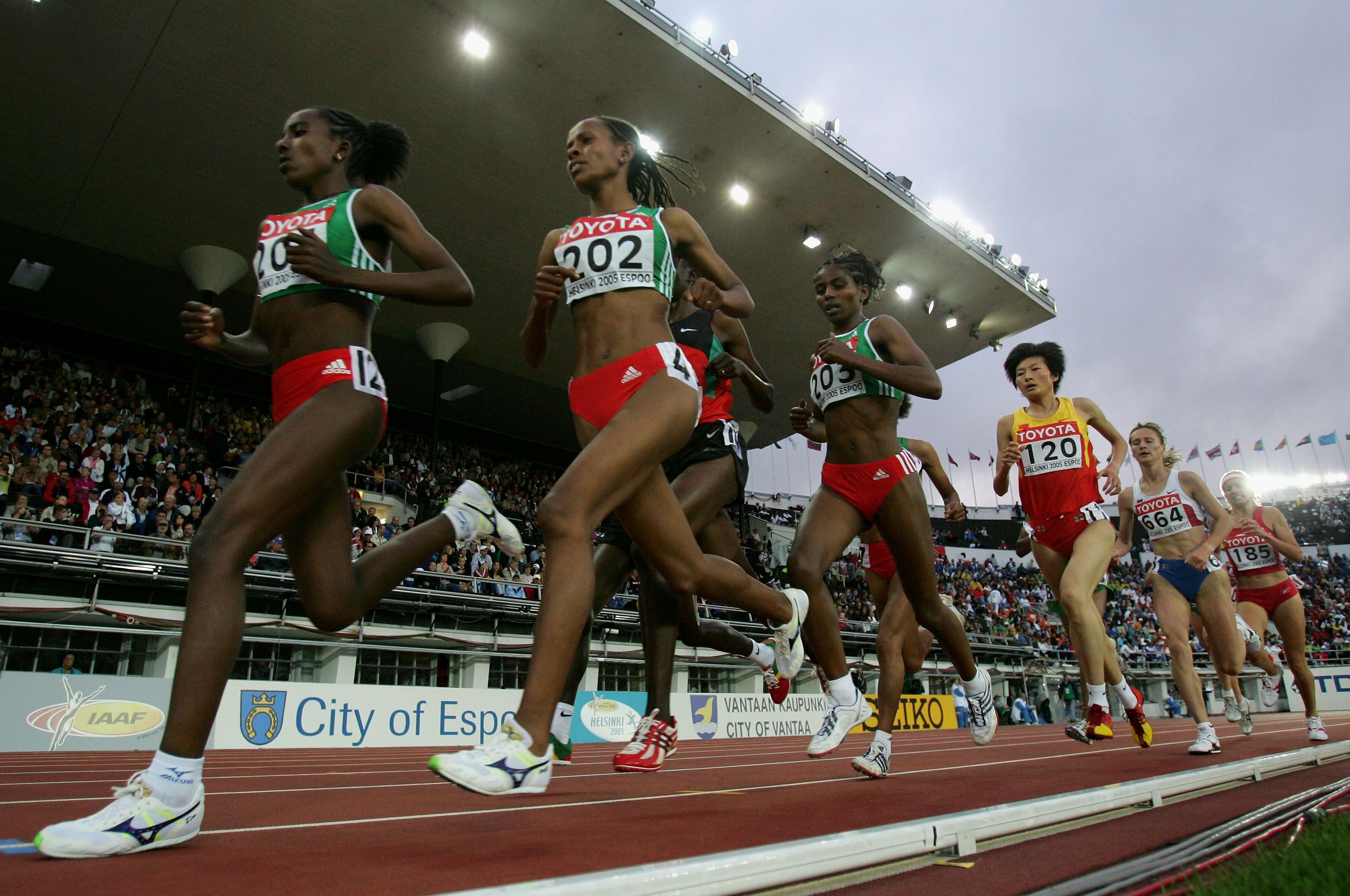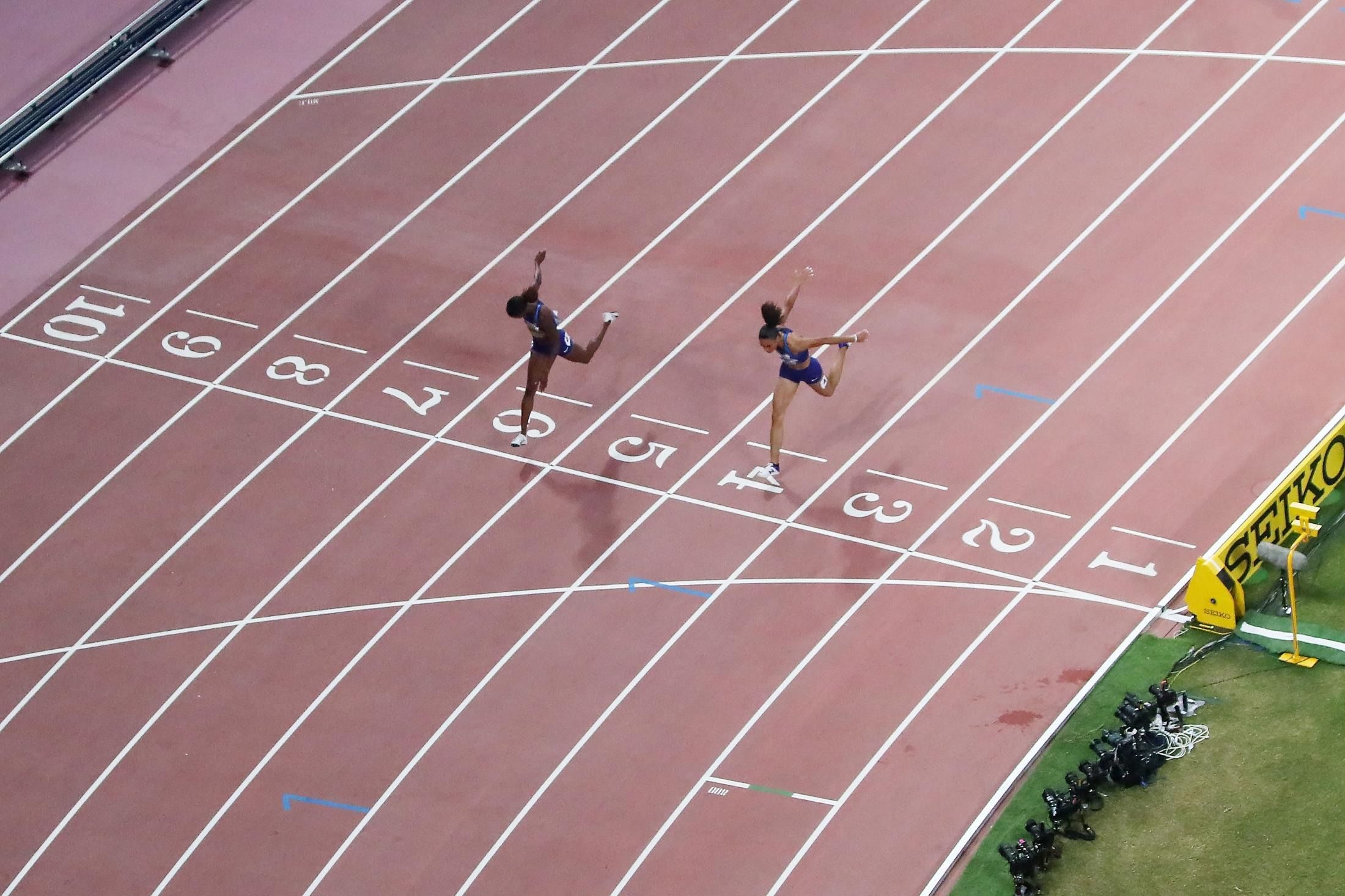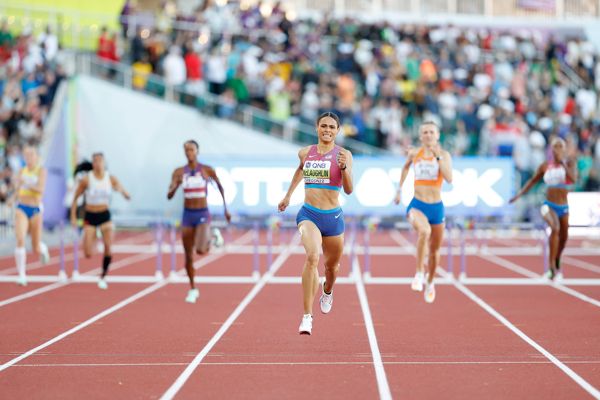With the countdown to the World Athletics Championships Tokyo 25 in full swing, we continue to shine a spotlight on the rivalries that have left a lasting mark on the sport’s grandest stage.
This is part two of a four-feature series as we revisit some of the most thrilling head-to-head battles that have defined women’s track events through the years.
Women’s 200m: Felix vs Campbell-Brown
The women’s 200m rivalry between Allyson Felix and Veronica Campbell-Brown was one of track and field’s most compelling battles. The women’s 200m final at the 2004 Olympic Games set the stage for a highly anticipated showdown at the 2005 World Championships in Helsinki. Felix had been tipped as the favourite in Athens and she set a world U20 record in the final, but it was Campbell-Brown who claimed Olympic gold.
Felix turned the tables in Helsinki to become the youngest 200m world champion, at the age of 19. She led a USA 1-2 in 22.16, with Rachelle Boone-Smith taking silver in 22.31 and Campbell-Brown settling for fourth.
Veronica Campbell, Allyson Felix and Christine Arron in the 200m in Helsinki (© Getty Images)
Two years later in Osaka, their first 200m clash came in the semifinals, where Felix again took the win ahead of her Jamaican rival. The final played out similarly: Felix caught Campbell-Brown on the bend and powered home to a world-leading 21.81 – her first sub-22 clocking. Campbell-Brown, fresh from winning the 100m title in Osaka, took silver in 22.34.
But at the 2008 Beijing Olympics, the Jamaican struck back, retaining her Olympic crown. Their next 200m clash came in 2009 in Berlin, where Felix made history with a third straight world title in 22.02, leaving Campbell-Brown with another silver.
In 2011, Campbell-Brown entered the Daegu World Championships in blistering form, winning both sprints at the Jamaican Trials. After silver in the 100m, she powered to 200m gold in 22.22, finally securing the world title. Felix, who had claimed 400m silver earlier in the championships, had to settle for bronze. The following year in London, the US sprinter achieved her own milestone – Olympic gold in the 200m in a race in which Campbell-Brown finished fourth.
Women’s 5000m/10,000m: Dibaba vs Defar vs Cheruiyot
The women’s long-distance rivalry of the 2000s and early 2010s was shaped by Ethiopia’s Tirunesh Dibaba and Meseret Defar, with Kenya’s Vivian Cheruiyot later joining the mix.
After winning the women’s 5000m at the 2003 World Championships in Paris, Dibaba made an emphatic statement in 2005. In Helsinki, Dibaba first led an Ethiopian sweep in the 10,000m before returning a week later to headline the first-ever women’s 1-2-3-4 in World Championships history over 5000m.
Sitting patiently with the leaders for much of the 5000m final, she unleashed her kick at the bell with teammate Defar giving chase. The pair battled to the line, but Dibaba prevailed in a championship record of 14:38.59, ahead of Defar (14:39.54) and Ejegayehu Dibaba (14:42.47). She became the first woman to win the 5000m and 10,000m double at a single World Championships.

Tirunesh Dibaba and Meseret Defar lead the 5000m in Helsinki (© Getty Images)
Two years later in Osaka, Tirunesh Dibaba successfully defended her 10,000m crown despite a fall. Defar, in world-record form, captured the 5000m title, while Cheruiyot took the bronze medal.
Injury kept Dibaba out of the 2009 Berlin and 2011 Daegu World Championships, where Cheruiyot seized control of the distance events. Cheruiyot beat Defar to 5000m gold in Berlin as Defar settled for bronze, then completed the 5000m and 10,000m double in Daegu, again with Defar third in the 5000m.
The London 2012 Olympics reshuffled the order again: Defar claimed 5000m gold ahead of Cheruiyot and Dibaba, while Dibaba retained her 10,000m title with Cheruiyot third.
At the 2013 World Championships in Moscow, with Cheruiyot absent, Dibaba won her fifth world title in the 10,000m, and Defar took 5000m gold, keeping their rivalry alive in one of the sport’s most competitive eras.
Women’s 400m hurdles: McLaughlin-Levrone vs Muhammad vs Bol
Over the past decade the women’s 400m hurdles has been shaped by three stars – Dalilah Muhammad, Sydney McLaughlin-Levrone and Femke Bol.
Muhammad bridged two eras, taking silver medals at the 2013 and 2017 World Championships before winning Olympic gold in Rio in 2016. That year, a teenage McLaughlin-Levrone made her Olympic debut but exited in the semifinals.
Their rivalry ignited in 2019 when Muhammad twice broke the world record – first with 52.20 at the US Championships, then lowering it to 52.16 to win at the Doha World Championships ahead of McLaughlin-Levrone (52.23).

Dalilah Muhammad edges Sydney McLaughlin-Levrone in the 400m hurdles at the World Championships in Doha (© Getty Images)
In 2021, McLaughlin-Levrone claimed the world record for herself at the US Trials (51.90) before defeating Muhammad in a Tokyo Olympic final for the ages, running 51.46 to Muhammad’s 51.58, with Bol taking bronze in a personal best of 52.03.
At the 2022 World Championships in Oregon, McLaughlin-Levrone obliterated her own world record with a stunning 50.68, with Bol taking silver (52.27) while Muhammad settled for bronze.
The 2023 season saw Bol in the form of her life and she maintained an unbeaten streak all season. The icing on the cake was her superlative performance at the London Diamond League where she raced to a Diamond League record, lifetime best, world lead and the third-fastest time in history (51.45).
At the World Championships in Budapest, McLaughlin-Levrone was absent, while Muhammad missed the final having finished third in her semifinal. Bol stormed to her first world title ahead of Shamier Little and Rushell Clayton.
Now, with McLaughlin-Levrone focusing on the flat 400m in Tokyo in 2025, Bol and Muhammad will duel once more – at Muhammad’s farewell World Championships – as the veteran aims to close her career with a final golden chapter.
Yemi Galadima for World Athletics
